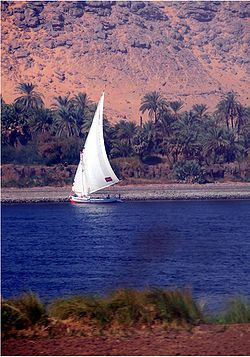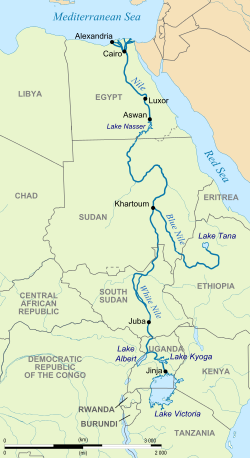Nile
The Nile (النيل an-nīl) is a river in Africa. It is the longest river on Earth (about 6,650 km or 4,132 miles), though other rivers carry more water.


Its longest section starts in Lake Victoria, and flows into the Mediterranean Sea near Alexandria. It gets its name from the Greek word "Νεῖλος" (Neil's).
This longest part is called the White Nile. It flows from Lake Victoria in Uganda, and through Sudan to Khartoum. There it is joined by the Blue Nile to form the Nile proper, which then flows through Egypt. The Blue Nile comes from Ethiopia near the Red Sea. The two branches meet near Khartoum, in the Sudan. About 300 million cubic metres of water flow down the Nile each day.
The Nile is essential to the drier countries in the north of Africa. On the Nile there are many boats: it is one of the easiest ways to get around. Historically, most cities in Egypt are built next to the river, and the pyramids are close to the Nile. The Nile has always provided most of the water used to grow crops in Egypt: much of the rest of the country is a desert. In ancient times the Nile flooded every year and the people would starve if there was not enough water for the crops. The Ancient Egyptians got papyrus from the Nile to write on. Papyrus is made from a plant which grows near the Nile.
Many different types of animals live in or near the waters of the Nile, including crocodiles, birds, fish and many others. Not only do animals depend on the Nile for survival, but also people who live there need it for everyday use like washing, as a water supply, keeping crops watered and other jobs.
Pyramids were built close to the Nile because they needed the granite stones from Aswan to be transported by barges down the Nile.
History of the word Nile
changeThe word "Nile" comes from Greek Neilos (ὁ Νεῖλος).[1] Neilos came from the word "river valley". In the ancient Egyptian language, the Nile is called Ḥ'pī or iteru, meaning "great river", represented by the hieroglyphs shown above (literally itrw, and 'waters' determinative).[2] In Coptic, the words piaro (Sahidic) or phiaro (Bohairic) meaning "the river" (lit. p(h).iar-o "the.canal-great") come from the same ancient name.
-
Ferry crossing the Nile River in Uganda
-
The Waterfalls of the Blue Nile
-
The Nile, at Aswan
-
The Nile, at the height of Luxor
References
change- ↑ Spelling of Greek taken from the Pocket Oxford Classical Greek Dictionary, 2002, ISBN 978-0-19-860512-6, p. 362
- ↑ What did the ancient Egyptians call the Nile river? Open Egyptology. (Accessed 17 October 2006)
Other websites
change- Nile River -Citizendium